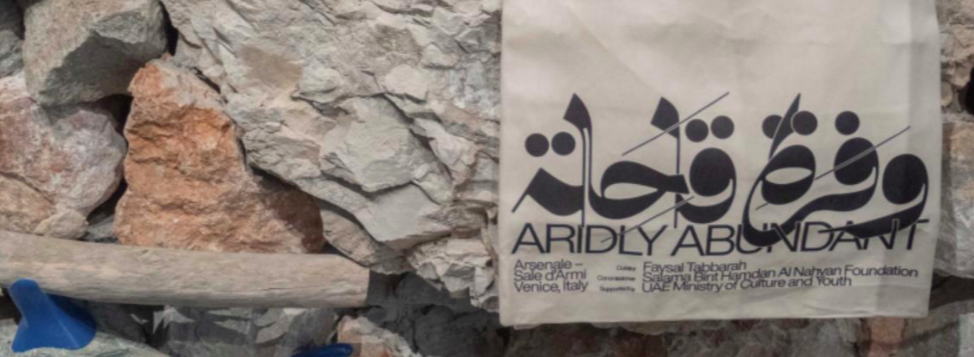
Design
A conversation with Faysal Tabbarah | Exploring the Paradox: Unveiling the Abundance of Arid Landscapes

A conversation with Faysal Tabbarah, the curator of the UAE National Pavilion exhibition “Aridly Abundant” at the Biennale Architettura 2023![]()
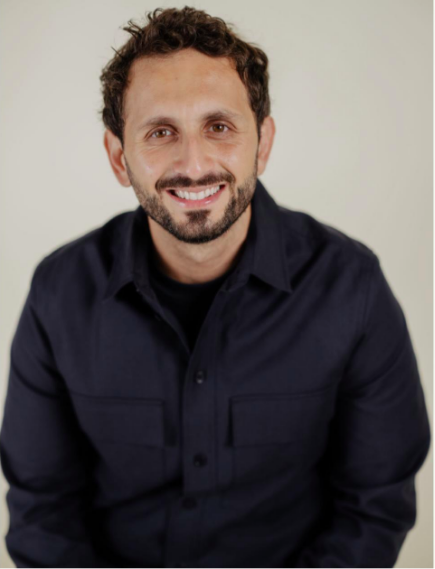
Image Courtesy of National Pavilion UAE La Biennale di Venezia.Image by Augustine Paredes
Meet Faysal Tabbarah, an imaginative architect reshaping our perception of space, culture, and the harmonious integration of our natural surroundings. Originally from Aleppo, Faysal works in the UAE and has already left a massive imprint on the design industry, delving into the connections between regional environments and architectural concepts to unravel how people integrate their natural surroundings into their perception and transformation of the world. Armed with cutting-edge computational tools, emerging technologies, and a deep dive into historical archives, Faysal’s work is a tapestry of creativity that pays homage to local materials and cultural influences.
Faysal is an Associate Dean and Associate Professor of Architecture at the College of Architecture, Art and Design in the American University of Sharjah (AUS). Beyond academia, he is also the co-founder of Architecture + Other Things (A+OT), an audacious design studio pushing the boundaries of experimentation. His work continues to show innovation, and A+OT’s latest triumph, “Water in the Green,” attests to that. This project clinched the top spot in the rivalrous Sabeel Water Fountains competition at Expo 2020.
His most recent work “Aridly Abundant”, an exhibition for the UAE National Pavilion set in the 2023 Venice Architecture Biennale, explored the architectural possibilities of reinventing arid environments as rich spaces. With a focus on the UAE’s ‘arid’ desert plateau, wadis, and coastal planes in and around the Al Hajar Mountains, Faysal and his team showcased spatial, material, and tactile qualities of such environments. We sat down with Faysal to take a look back and learn more.
By Yosr Sherbiny
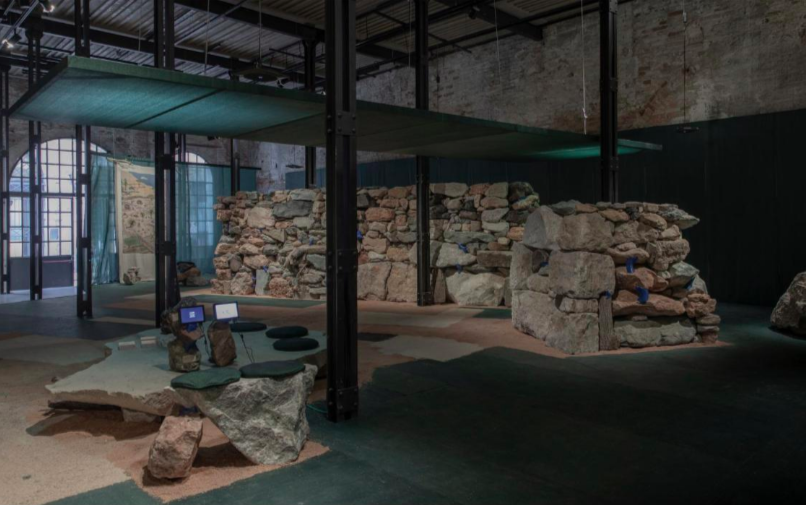
2023. Aridly Abundant. Image Courtesy of National Pavilion UAE – La Biennale di Venezia. Photo by Ismail Noor of Seeing Thing
The year is 2050. You are looking out onto what was once considered an arid land, and you see…
Faysal: A change in understanding of the word ‘arid’. Aridity is not bad, it is not problematic. In fact, it is good. Aridity is a condition, just as extreme cold (or heat) is a condition, and there are ways in which people have inhabited and shaped those spaces, historically.
You are reframing the narrative of arid landscapes. How has this narrative already shifted from 30 years ago?
Faysal: I don’t know if one can really say that the narrative around aridity or landscapes in general has changed over the last 30, or even 10 years. The narrative, unfortunately, persists. However, there is an emerging critical position within architecture (and with adjacent practitioners) to think about landscapes’ role in culture, and in how we build. There is a history of thinking about (our) desert landscape as a productive condition within literature. For example, authors such as Abdelrahman Munif (Saudi Arabian) and Ibrahim Al-Koni (Libyan) have centered deserts as protagonists within their stories.
“(…)there is an emerging critical position within architecture (and with adjacent practitioners) to think about landscapes’ role in culture, and in how we build. “![]()
How have your personal identities and experiences shaped the work you do now, as an architect and researcher?
Faysal: Personally, I’m interested in questioning constructed narratives about land in South West Asia and North Africa. Constructed narratives are not completely accurate, so they tend to allow certain (prejudicial) decisions to be made. Our imagination of the so-called ‘natural environment’ is connected to how we imagine, conceive and build, which is why my work encourages the audience to think about stories of landscapes and challenge them so that we might uncover ways in which we can have a more (regionally) rooted built-environment.
![]()

Image Courtesy of National Pavilion UAE La Biennale di Venezia & Faysal Tabbarah. Photo by Faysal Tabbarah

How has your research changed the way you understand landscape (whether natural or man built) in the UAE?
Faysal: It all comes down to mode of research. Doing field work, or landscape field work, teaches people how to see things with a little bit more insight, and nuance. There’s a vast difference between experiencing landscapes as 2D images and in real life, whether by car or foot.
For “aridly abundant”, the work really centered around exploring Al Hajar mountains (on the UAE’s East Coast) via various modes of research, to understand the different transitions that relate to the landscape. For example, as we drove towards the area, the mountains seemed to emerge from the fog, and as we got closer, more of the mountain range revealed itself. At some point, we realized that the roads crossed through the mountains, which made me think of how we adjust the shape of nature to accommodate us. There are also different roads that you can take to Al Hajar mountains, which will give you different perspectives and transformations. One road showed us the change from urban landscape to peri urban to smaller scale urban, to desert, and gravel plane. Other roads may show you how the mountain meets the water on the east coast, a historical fertile strip that is still agriculturally rich.
Fieldwork also necessitates that one explores by foot, to shed light on certain transformation details in the landscape that might not have been apparent from a distance, such as investigating the relationship between the land and the water (Wadis), identifying the different vegetation, and assuming what was historically built by studying the layering of the stones.![]()
Image courtesy of National Pavilion UAE La Biennale di Venezia. Photo by Reem Falaknaz

What are some of the conversations that took place with the UAE Pavilion team that tied into the Biennale Architettura 2023’s theme “The Laboratory of the Future”?
Faysal: The fact that the conversations that took place and the work (by the UAE National Pavilion) already responded to Lesley Lokko’s “The Laboratory of the Future” suggested that there was a common research thread in the realm of architecture where people are thinking about how things have been made.
We explored three main avenues that reflected questions about the past, the present and the future. The ‘How can we build in aridity’ recognised that there has been activity in arid landscapes historically, and that there was something to learn from. ‘How can we build with aridity’ suggested questions around the abundance in arid materials that exist in arid landscapes, today. The third question ‘how can you build for aridity’ which suggested aridity is something that is a historical condition in the UAE and then the region at wide, but as a future condition for many other places in the world. So how could we transplant some of the lessons, attitudes, and some of the tactics that we’ve learned within the UAE into other avenues or other locations.![]()
2023. Aridly Abundant Image Courtesy of National Pavilion UAE – La Biennale di Venezia. Photo by Kathleen Hoare of Seeing Things


Tell us about the team who worked behind creating the magic for the exhibition, as well as your supplementary publication.
Faysal: The exhibition, and the publication, provided an incredible opportunity to bring together a group of AUS alumni, pooling their experiences to create this remarkable work. The core team is made up of 6 alumni from the AUS College of Architecture, Art and Design, including researchers, designers, led by Samar Halloum. Using their interdisciplinary design skills, some members explored the high level challenges of designing a space, while others explored digital workflows. Another AUS alumni that played a major role is Reem Falaknaz, our principal photographer for the publication, who also created four short videos capturing her own experiences and narrating them to the visitors. And finally, the last alumni is Meitha Almazoorei who collaborated with me on co-editing the publication.![]()
![]()
2023. Aridly Abundant. Image Courtesy of National Pavilion UAE – La Biennale di Venezia. Photo by Kathleen Hoare of Seeing Things

Walk us through your curation process and research framework.
Faysal: It all comes down to exploring one question, “what architectural conditions can become possible if we re-think arid landscapes as spaces of abundance?”
As a team, we established a three part framework that have certain interconnected relationships between them. The first is places, or architectural spaces, which are Al Hajar mountains in this case. The second is the wide array of materials that we’ve observed being used in Al Hajar mountains, historically and today. And the third is tactics – this is an interesting one. Tactics is the way in which individuals and groups have used materials to put things together in a way that does not necessarily align with mainstream construction. And those three come together.
An example of materials and tactics coming together is dry-stack stone wall built on top of CMU stone that is also kind of held together with two or three pieces of steel. This makes what we’ve internally called misfit assemblies, that privilege a particular goal over what is potentially considered proper construction.
Misfits, just like arid, is not necessarily a bad thing.
We’ve also done a lot of field research, a lot of photography, informal interviews with the locals, and with agricultural organizations to have a little bit more data. And all of this came together into an exhibition that, from the beginning, was conceived as an environment instead of a place that “exhibits things”.
Image courtesy of National Pavilion UAE La Biennale di Venezia. Photo by Reem Falaknaz

2023. Aridly Abundant. Image Courtesy of National Pavilion UAE – La Biennale di Venezia. Photo by Ismail Noor of Seeing Things
Highlight one of the advanced construction technologies that were used in the creation of the exhibition.
In terms of technology, we have chosen to concentrate on utilizing the advantages of 3D scanning and 3D printing due to the adaptable nature of these methods.
We used 3D scanning to capture the details of stone fragments obtained from the local region of Veneto, which was as close as possible to our site in Venice. Typically, all artists and architects ship the material from their countries to the Venice Biennale. We didn’t want to go down that route. We were challenging this. We also wanted to make use of locally available materials that would usually be discarded.
After conducting 3D scans of the stone fragments, we utilized 3D printing to generate practical molds for casting aluminum elements. These elements served as amplifiers, enhancing the value of the otherwise discarded stone material.
Is the idea of reframing arid landscapes contextual? Is your work a module/ prototype that can be carried forward in different contexts?
Faysal: The answer here is contradictory; yes it is contextual, however the results may have been similar in different landscapes. The work is directly linked to the UAE and its wider region, which is considered to have a high percentage of arid desert. But the question on aridity is international. For example, what happens in Italy, when they start to struggle with aridity? The government has already announced that this is a year of drought, especially in Northern Italy, which is a major economic powerhouse. So what does that mean? How can they reshift their own conception of an Italian landscape or a Northern Italian landscape, to be able to confront questions of identity?
In 2023, the UAE had dedicated the year to sustainability, under the theme, ‘Today for Tomorrow’, what is one wish you have for the future (from a sustainability lens)?
Faysal: For practitioners to adopt a universal attitude that technology is not the only answer. It is only part of the answer. We can integrate land-based historical knowledge with technology to provide solutions that are rooted in their landscapes. The UAE excels in asking questions related to technology. We need to further investigate the balance between technology and historical knowledge.
2023. Aridly Abundant mage Courtesy of National Pavilion UAE – La Biennale di Venezia. Photo by Kathleen Hoare of Seeing Things
About the Exhibition
Commissioned by The Salama bint Hamdan Al Nahyan Foundation, The National Pavilion UAE will presented its exhibition for the 18th International Architecture Exhibition, from 20 May to 26 November 2023. 2023 marked the UAE’s 12th exhibition at the Art and Architecture International Exhibitions organized by La Biennale di Venezia since 2009 and its 5th participation in the International Architecture Exhibition.
#AridlyAbundant #LaBiennaleDiVenezia #BiennaleArchitettura2023 #UAEinVenice #TheLaboratoryOfTheFuture
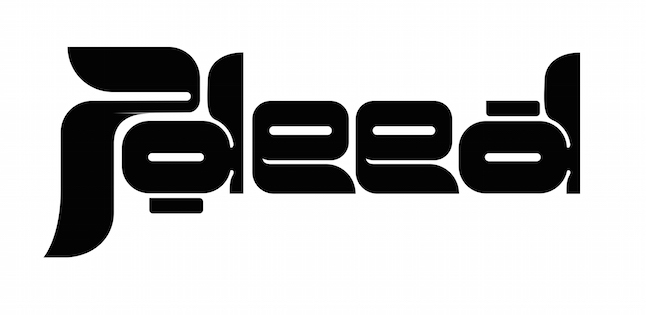
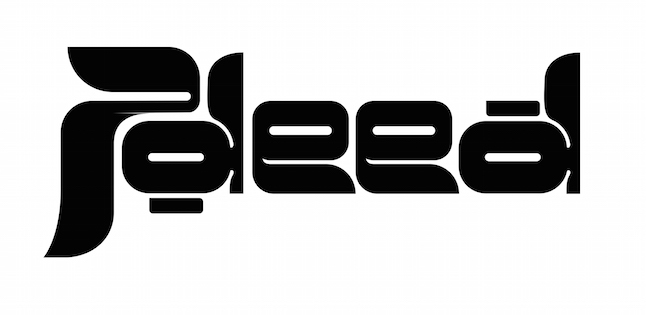




0 comments